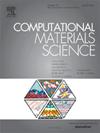Molecular dynamics simulation of interfacial thermal conductance in RDX/PVDF mixture explosives
IF 3.1
3区 材料科学
Q2 MATERIALS SCIENCE, MULTIDISCIPLINARY
引用次数: 0
Abstract
The interfacial thermal conductance of mixtures formed with hexahydro-1,3,5-trinitro-1,3,5-triazine (RDX) as the explosive and polyvinylidene fluoride (PVDF) as the binder were investigated through reverse non-equilibrium molecular dynamics (rNEMD) simulation. A combined force field, incorporating the modified Smith-Bharadwaj, PCFF, and RDX/polymer interfacial force fields, was employed to model the systems. The thermal conductance of six RDX/PVDF interfaces composed of PVDF (010), (001) and RDX (001), (010) and (100) crystal planes were calculated, respectively. The orientation-dependent thermal conductivities of both the RDX and PVDF crystals were determined. PVDF molecules in the three RDX/PVDF(001) structures tend to rotate and put shear stress on RDX crystal, causing a deformation of RDX emerged in (001) plane, which is known to exhibit the lowest stability against shear. Consequently, these structural changes influence the thermal conductivities of the corresponding bulk monocrystals. The interfaces in RDX/PVDF(001) structures are formed after the rearrangement of RDX and rotated PVDF molecules and act as mixed buffer layers which enhance their interfacial thermal conductance compared to those in RDX/PVDF(010) mixtures. Among the three RDX/PVDF(010) interfaces, the interfacial thermal conductance of RDX(001)/PVDF(010) is higher than the other two. Further analysis of the vibrational density of states and the interfacial atomic pair distribution function indicated that intermolecular hydrogen bonds, especially H (RDX)···F (PVDF) bonds, play a significant role in the thermal transport across the RDX/PVDF(010) interface.

求助全文
约1分钟内获得全文
求助全文
来源期刊

Computational Materials Science
工程技术-材料科学:综合
CiteScore
6.50
自引率
6.10%
发文量
665
审稿时长
26 days
期刊介绍:
The goal of Computational Materials Science is to report on results that provide new or unique insights into, or significantly expand our understanding of, the properties of materials or phenomena associated with their design, synthesis, processing, characterization, and utilization. To be relevant to the journal, the results should be applied or applicable to specific material systems that are discussed within the submission.
 求助内容:
求助内容: 应助结果提醒方式:
应助结果提醒方式:


